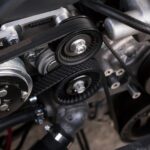ABS, or antilock braking system, has been familiar to us for a long time, but it can still puzzle us. Why does its light sometimes light up on the dashboard? Something is broken, and it’s time to save money for repair or can we do without a lot of trouble? It happens differently, but more often there is no reason to panic.
It’s simple
It may look strange, but the antilock system came to the aid of motorists not from somewhere, but from the railroad: they started using it there in the 20s of the last century. Of course, ABS had another task at that time: to block wheels of a train while braking didn’t make it skidding, but practically destroyed cast-iron wheels. And that’s why railroads were the first to invent systems that would not allow the wheels to buckle under braking. And a little later, the first ABS appeared in aviation, where it was very important to stop the plane quickly on the runway after landing and not to let it leave the runway. And only 50 years later, the antilock braking system appeared on serial cars. At first – as an option, and then, in 1978, it became base on Mercedes-Benz W116 and “Seven” BMW. Now, as you know, in Russia this system was given up, but it is temporary – it is impossible to imagine a safe car without ABS, and this system is not so difficult to find a way out of the situation.
What’s the light on?
Let’s start with the good news: sometimes a burning ABS light has nothing to do with a broken system at all. It happens when the wheels on one axle are stationary and the other axle has been spinning long enough and fast enough (or one wheel has been spinning, which is more common). Yes, this is a classic situation when slipping for long periods of time while trying to get out of mud or snow. After this action (often, let’s face it, quite useless) the ABS control unit goes crazy with sensor readings from the hubs and lights the lamp just from not understanding what is going on. After several kilometers, the lamp goes out and the system works normally. There is nothing wrong here, it is normal. It is worse, if there was no slippage, but the system is blaming something.
If it happened after replacement of a hub bearing, a hub assembly or a brake disc (in some cases), the ABS signal is not accidental. Most likely, whoever did the work didn’t pay too much attention to the installation of either the ABS sensor or its rotor (“comb”, “ring”, pulse or set rotor – there are different names for this part). In case of excessive crookedness of hands of service station employee, such variant is not only possible, but also very popular.
Sometimes this floating error may not be connected with ABS at all. The thing is that the “comb” is on the hub, and the sensor itself is very close to it, but on the stationary part of the car. The distance between them should be kept very accurately, but if the hub bearing collapses completely, the hub starts to play. And this causes the signal from the sensor to periodically go out. Honestly, I don’t think a person who has listened to the howl of a dying bearing for several hundred or even thousands of miles in peace will get worried when the ABS light is on, but still.
Another reason for the light to light up on the go is a lack of signal due to contamination of the sensor or pulse rotor, or a breakdown of the latter. In the former case, the repair comes down to cleaning the sensor and rotor. You can do it yourself, unless, of course, removal of the wheel does not cause significant difficulties (without this procedure you can not get to the sensor). You can clean both the sensor and the rotor with anything (even kerosene, carbcleaner, or an old T-shirt), the main thing is not to damage the wiring. But if you find during cleaning that the rotor is damaged (missing teeth or it just fell apart), of course, you will have to replace it.
It is much more interesting to look for a breakdown in which the system cannot self-diagnose after the ignition is turned on. That is, one in which the ABS lamp doesn’t go out a few seconds after the ignition is turned on or the engine is started.

With a tester in hand
The most likely cause of the self-diagnostic failure is a sensor failure or a break in its wiring. It is easier to start checking with the sensor itself. The easiest method is to check its resistance with a multimeter in ohmmeter mode. Different sensors have different resistances, but on average it should be between 1 and 2 kohms (more often even up to 1.5 kohms). These numbers can be used as a guide, although of course it is better to know the resistance more accurately. But the main thing is not to see zero or infinity on the multimeter: in the first case, it will indicate a short circuit, in the second – a break. Repairing the ABS sensor is useless, it will have to be replaced (which now may not be very easy due to the shortage of these parts on some cars).
For your own pleasure, you can hang out the wheel and spin it. Its sensor resistance should change. If it does not, then, probably, either there is something wrong with the “comb”, or just the sensor works, but is very dirty. In that case, though, the ABS light usually comes on on the fly, not after a failed self-diagnosis.
The wiring is more difficult to check. The ideal option is to check it with the sensor connected. But to do that, you have to remove the pad from the ABS unit and find the pairs of wires in the terminal that match from each of the wheel sensors (which are usually different colors). If at this stage, the work seems too complicated, it is better not to torture yourself and the car and go to the service.
It is necessary to note, that if there is an unreliable contact in a chain, it can be difficult to find a problem in such way: by the law of meanness, at the moment of diagnostics, the contact can appear to be reliable. To at least somehow minimize this probability, you can ask an assistant to rock the car during the measurement. Of course, such oscillations will not exclude the possibility of error completely, but sometimes it may help to notice the jumping numbers on the screen of the tester.
More often there is no signal from the sensor, if it is out of order, or if its connector is oxidized and dirty. On older cars, of course, there can be anything, but on more or less recent cars the ABS control unit fails rarely, and the wiring does not rot for a few years. And if it is block that is responsible for burning of a light, it is better to go to service: it is not so simple to repair it with your own hands.











